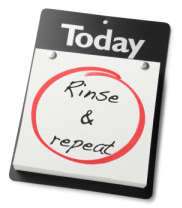As we discussed earlier in the week, there is no such thing as an “active candidate” (someone that needs a job from your company) in the world of real estate. By default, all prospective agents are “passive candidates.”
Since passive candidates don’t need a job at your company, they are evaluating if working with your organization is better than what they are currently doing. Often, their easiest option is to do nothing.
To treat passive candidates (especially new-to real estate prospects) as if they are active candidates is a mistake. It destroys your chances of convincing high-quality individuals to join your organization.
With this foundation in place, Peter Weddle addresses one more issue during telephone screening that commonly derails the passive candidate recruiting process.
The issue is inconsistent messaging.
Peter puts it this way in his recent newsletter:
“In order to engage and effectively influence passive prospects…the recruiter begins the call and continues the selling effort for an opening that was begun in the recruitment ad to which the applicant replied.
This short but carefully orchestrated period should not be used simply to restate the information in the ad, but rather to highlight the key elements of its value proposition. In other words, what makes this opening a special opportunity and what makes the employer a special place to work?
The purpose of this initial interaction is "re-recruitment." It's done to remind the passive prospect why they applied for the job and to reinforce the position's potential advantages for them.”
Notice how the telephone screening builds upon the message the candidate “heard” when they responded to the initial sourcing event. Typically, a sourcing event would be a job advertisement, but it could also be something like an agent referral or a visit to the career page of your company’s website.
If the initial sourcing message and the next contact (the telephone screening) do not complement and support each other, the candidate will typically sense the disequilibrium. When this happens, the red flags go up in a prospect’s mind.
Researchers have frequently demonstrated that the human mind doesn’t like disequilibrium when it is trying to assimilate new information. If candidates can’t quickly find equilibrium during the telephone screening (“This makes sense based on what I initially heard…”), they’ll eject themselves from the recruiting process to find that equilibrium (“Changing careers was probably not going to work for me anyway. What was I thinking?…").
By the way, the same principle applies to the interview stage of the recruiting process.
If the messages at these three recruiting junctures (initial sourcing event, telephone screening, and interview) do not match and support each other, your recurring success with passive candidates will be greatly diminished.
If you remember the take-away from part one of this discussion—all prospective agents, new or experienced, are passive candidates—you can see why it’s so important to master this technique.
Here is some final advice from Peter:
“The telephone pre-screen is often implemented as a mechanical element of the recruitment process – a pass-fail test that is all about what the employer wants to know. By [being consistent in your messaging] you can both assess applicants more effectively and get more of them – especially those elusive passive prospects – to accept any offer that is made.
Consciously or unconsciously, passive prospects believe that the way they are treated in the recruiting process mimics the way they will be treated as employees, so it's essential to optimize their experience from the beginning to the end.”
Exactly.
Join the WorkPuzzle Discussion at the Tidemark Online Community (TMOC)
Engage in the WorkPuzzle discussion by joining the TMOC private social network. Commenting on a public blog like WorkPuzzle can be a little intimidating, so why not join the discussion inside the privacy of the TMOC discussion group?
By joining TMOC, you'll get to see who else is in the group and your comments will only be seen by those whom you trust. Joining TMOC is quick, easy, and free (no kidding…this takes less than 2 minutes). To get started, click here.
Already of a member of TMOC? If so, join the WorkPuzzle Dialog Group by clicking on the WorkPuzzle Group icon on the left side of your TMOC homepage. Questions? Email the WorkPuzzle editor (workpuzzle@hiringcenter.net) and we'll walk through the process.
 Editor's Note: This article was written by Ben Hess. Ben is the Founding Partner and Managing Director of Tidemark, Inc. and a regular contributor to WorkPuzzle.
Editor's Note: This article was written by Ben Hess. Ben is the Founding Partner and Managing Director of Tidemark, Inc. and a regular contributor to WorkPuzzle.













